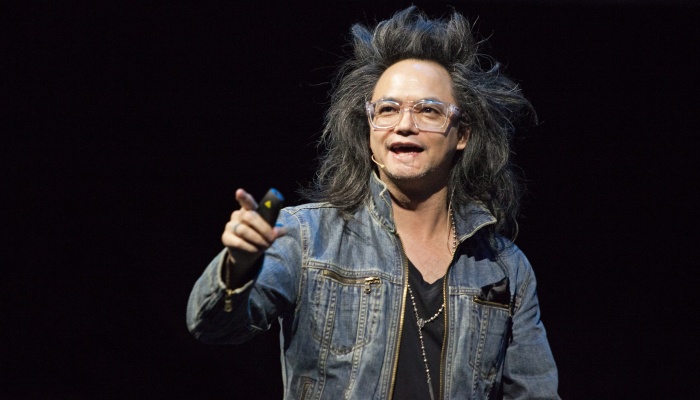
He may have the most interesting designation as the Digital Prophet of AOL but there is no doubt David Shing knows just how to challenge any convention or norm that the advertising business, knowingly or unknowingly, follows.
From questioning marketing strategies to the very mindset of advertisers, Mr Shing put a lens on the generation that is born in the digital age at the Dubai Lynx International Festival of Creativity.
He quoted a study to highlight that the connected generation wanted to achieve happiness, spend time with family and friends, be true to themselves and be financially stable. “These values are more closely aligned with their grandparents’ generation than their own parents. This generation gets its information from feeds – they are too busy for us but they represent a significant category of spend. It is expected that by 2025, this generation would be spending USD 2.45 trillion,” Mr Shing explained.
Delving further, he cited the study to point out that around 88 per cent of this category believes that their best is yet your come. Around 79 per cent believes in the ‘trust your gut’ instinct, which essentially implies creativity, and only 75 per cent is of the opinion that technology gives them control. “There clearly is still some way to go in technology, so it is still about getting the creative right, and about us as brand ambassadors thinking about how to create differently,” Mr Shing pointed out.
Mr Shing reminded the audience if a brand gets its content strategy right, it is not just competing with advertising but popular culture. In that background, creativity has to be redefined, and for Mr Shing, content represented a very significant part of the new-age creative strategy.
In revisiting content, there are various ways to demarcate it. There is the evergreen content, which would never expire and is valuable for the brand but there is also the seasonal content, where people will “pop by” the brand before anyone else. “And then there is the ‘now’,” stated Mr Shing, adding, “Brands have the challenge in earning the breaking news.”
He mentioned the ‘Bend Gate’ ad by iPhone 6 as an example here, where the iPhone 6 ad was followed by Samsung, LG and even chocolate brand Kit Kat saying, we ‘Break’ at 45 degrees, in line with Kit Kat’s brand proposition of a ‘Kit Kat Break’. “You don’t have to own the news but just be part of the currency and the halo around it. There is immense opportunity here,” he said.
Put Your Money Where Your Mouth Is
Another commonly discussed concern in the Middle East and North Africa (MENA) region is that while brands are speaking about digital and video, they continue to earmark significant portion of their ad budgets to television. Adding the affinity that brands have for tent-pole strategies, Mr Shing advised that at present brands are busy speaking to consumers before and during the moment but not after.
“The way I see it, there has to be a mindset change and we have to talk to our audience before, as it happens and after the event too, when the chaos settles down. The fact is that Digital is the first and the only place where the brand can own the breaking news. You just cannot do it anywhere else because there are too many gatekeepers. This is where brands have a direct connect with the consumers. People’s behaviour is influenced by their peer, and it would more so as we go on,” he said.
The challenge continues that despite all the digital amplifiers, there still are not too many opportunities for a brand “to brag about itself”. The need for being compelling is much more pronounced today. “We say build good content and put it in smart places, but it is very hard to actually do that. Context matters. The challenge is that the world is overwhelming with the volume of messages in a day and then it is underwhelming because there are times when you don’t find what you are looking for. The stuff we are producing is stressing us out,” Mr Shing asserted.
Attention: The Economy We Care About
In everything that is changing in a digital age, the only absolute is that there are 24 hours in a day. Brands have to think about being “present” with the consumer. “The only economy we care about today is attention. How we choose to devote our attention is a reflection of what consumers are doing too. The digital behaviour is changing radically. And yet, many brands still treat their mobile strategy as infant. This is complete rubbish because it was in 1997, when Coca-Cola first text messaged to interact with its vending machine. You have to experiment. Instead we have taken desktop ads and put it on mobile. And guess what – it is not that great. To top it, there are rubbish ads out there,” Mr Shing remarked.
For him, the behaviour shift is towards utility and being practical. What people consume is app driven and only 70 per cent consumers will try it once, so the brand has to bring real value for people to try the app and remain engaged.
This is important even more today as the world is moving from awareness to advocacy. Mr Shing elaborated, “When you build things now, you have to remember it is for a person who is always on, always with and always logged in. Imagine you can do with that. But whatever you do, keep it simple. As Da vinci said, simplicity is the ultimate sophistication.”
Sharing: The Verb We Care About
Mr Shing also reiterated the importance of people’s behaviour of ‘sharing’. “Sharing has links to content it is the verb that we care about. This brings me to native. It was called advertorial when I was a kid – you can call it native or whatever now, I think it is naive. We have to take a hard look at what we call paid media strategy today, meaning you cannot buy ads. I also believe it is a new revolution of advertising. Brands need to act like human in places where they cannot advertise, and this itself opens up many conversations on what the future of communication should look like,” Mr Shing summed up.




